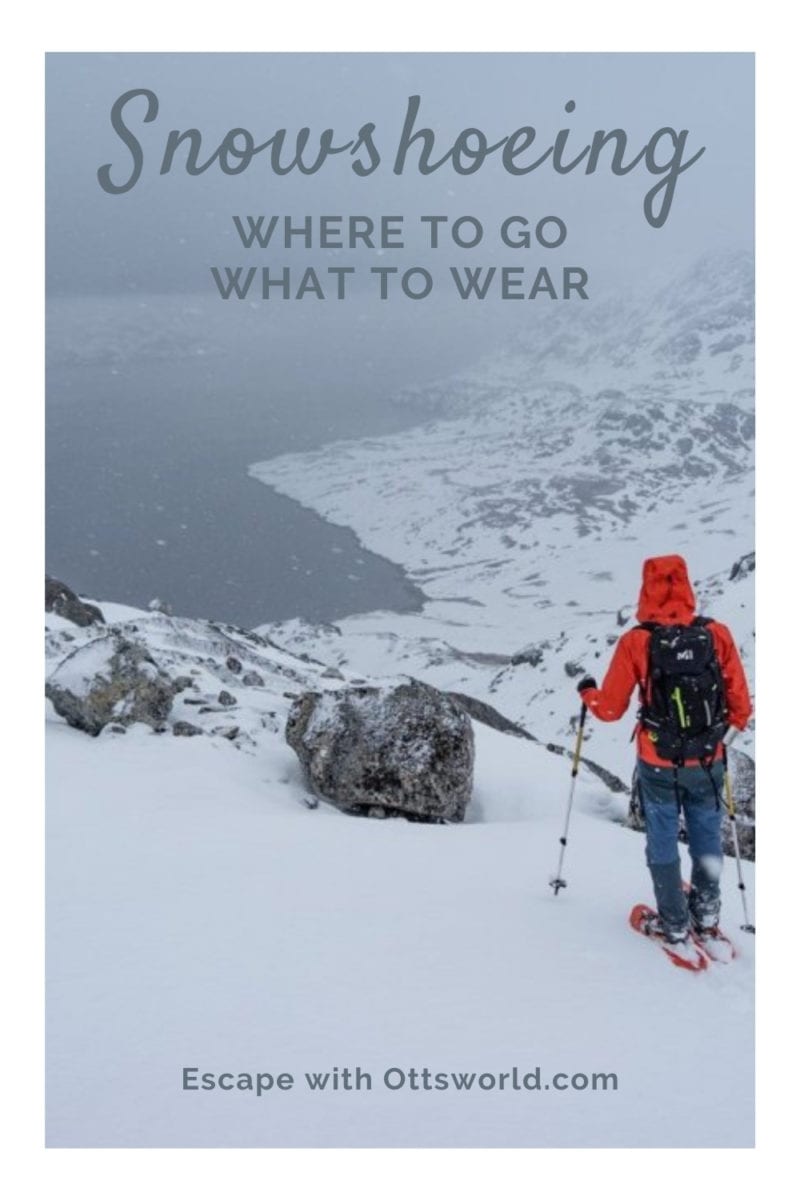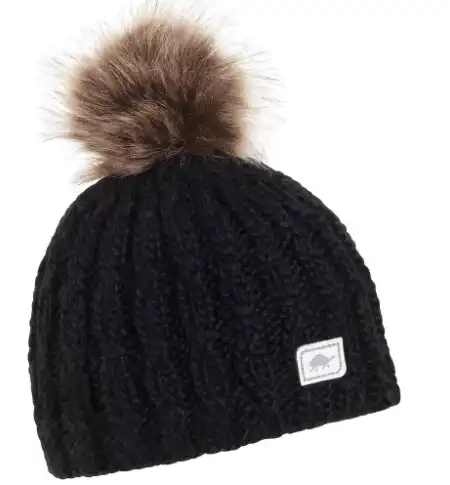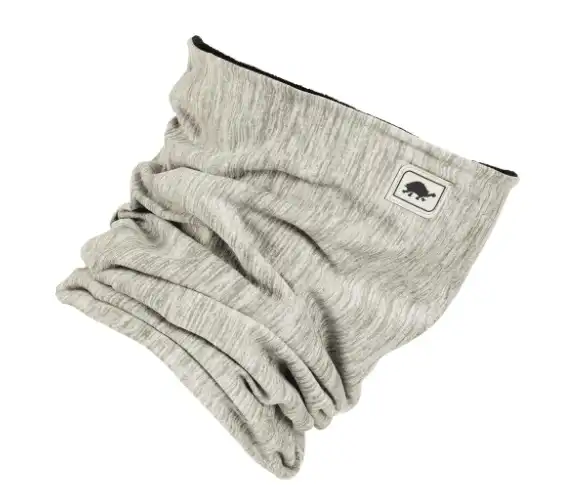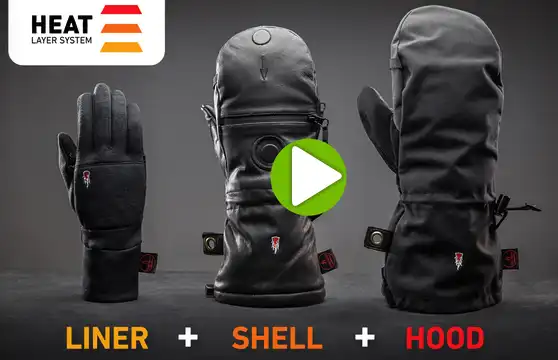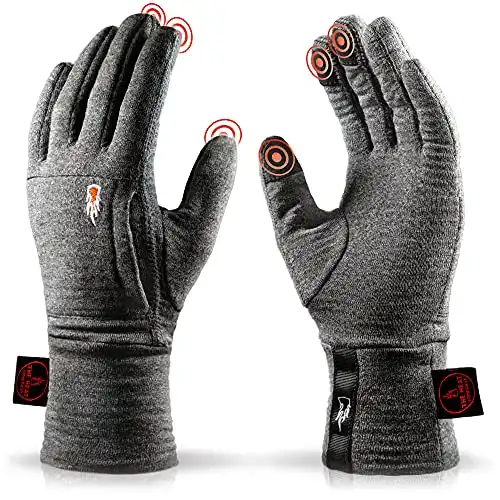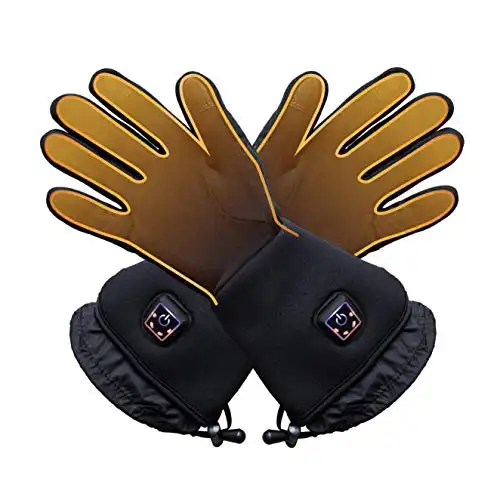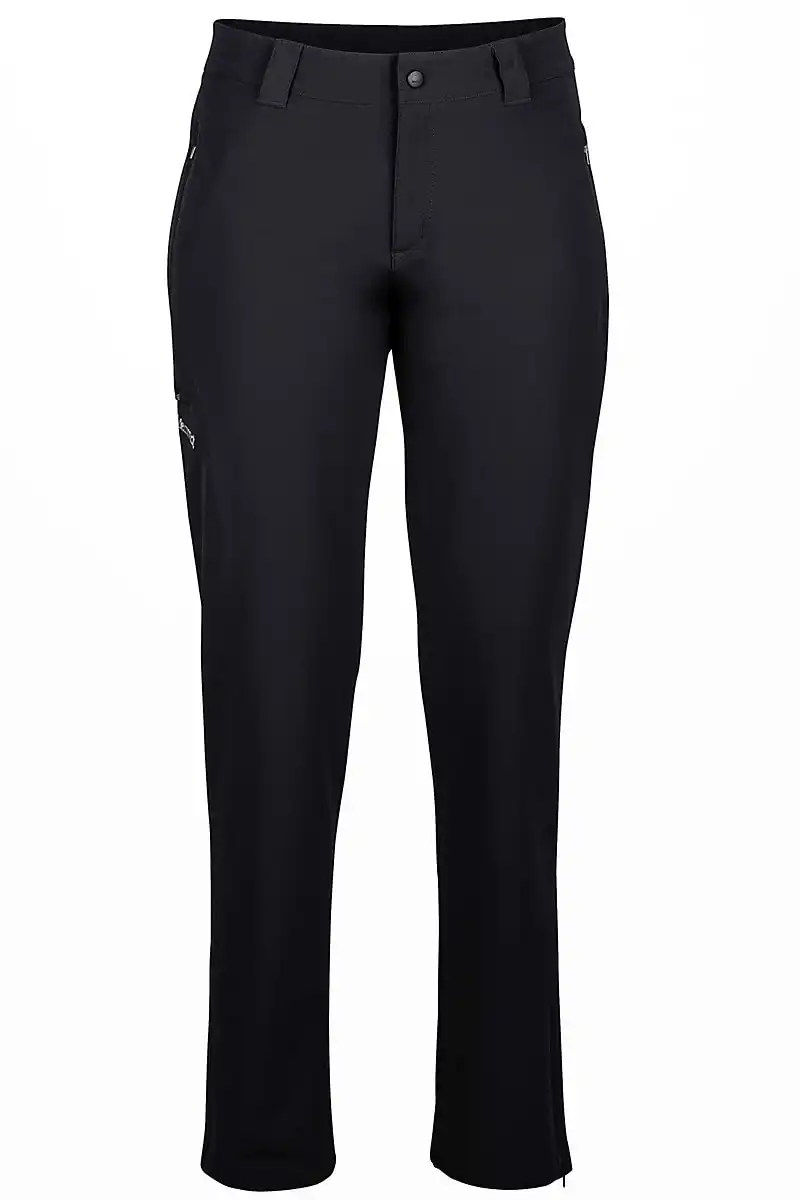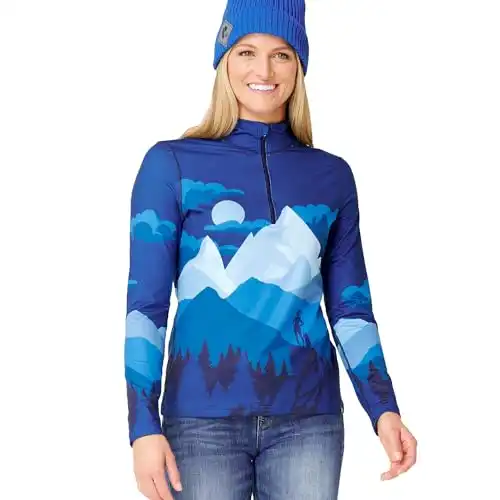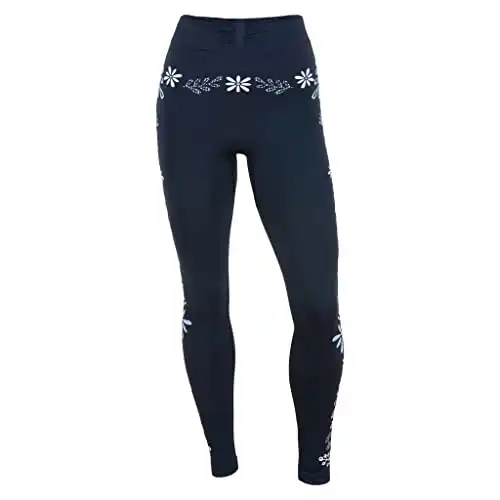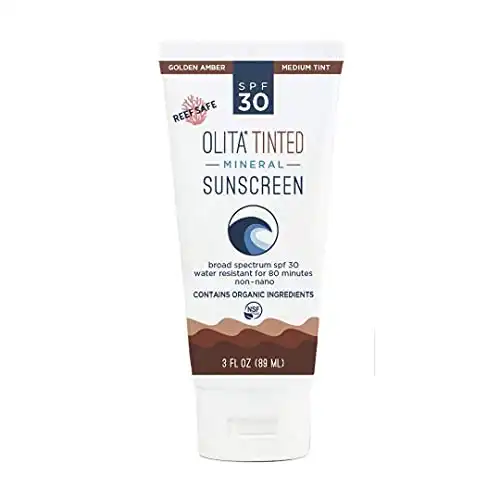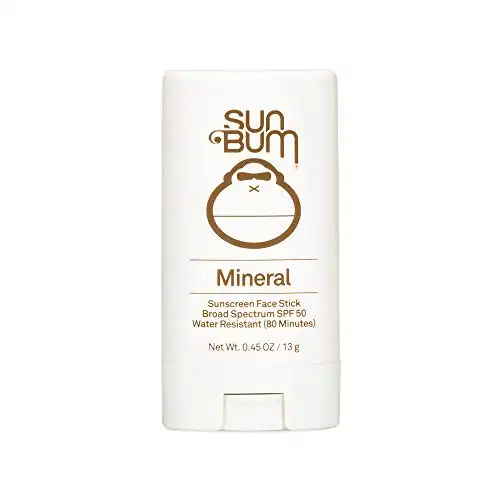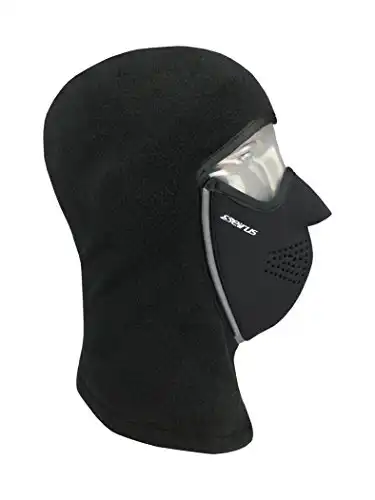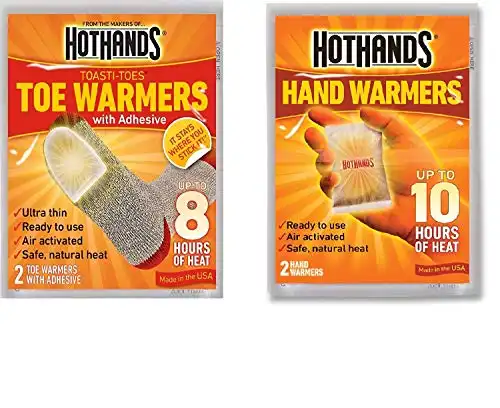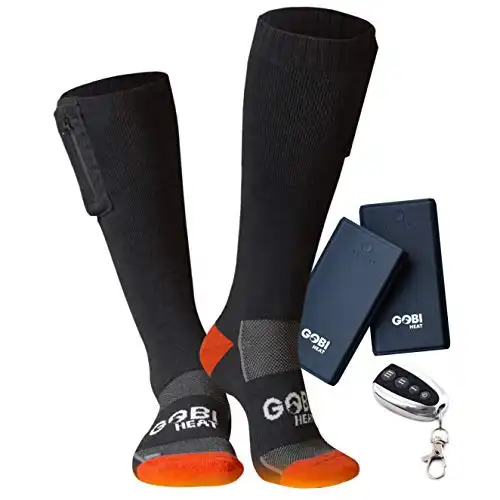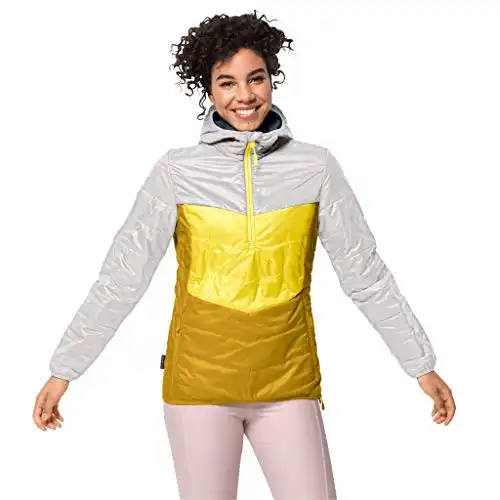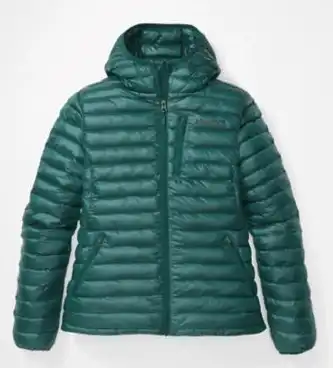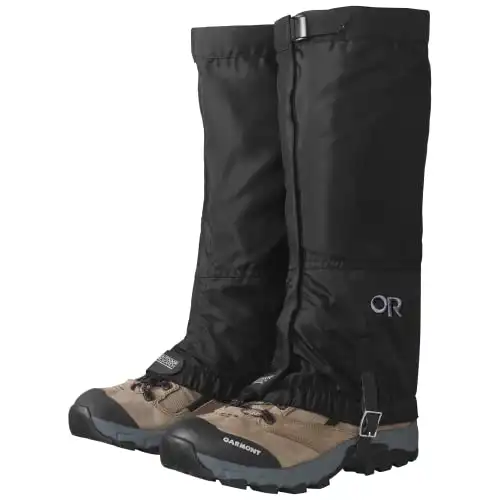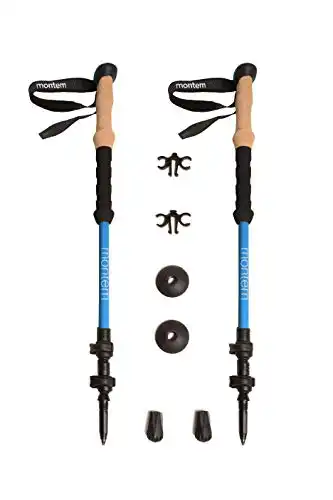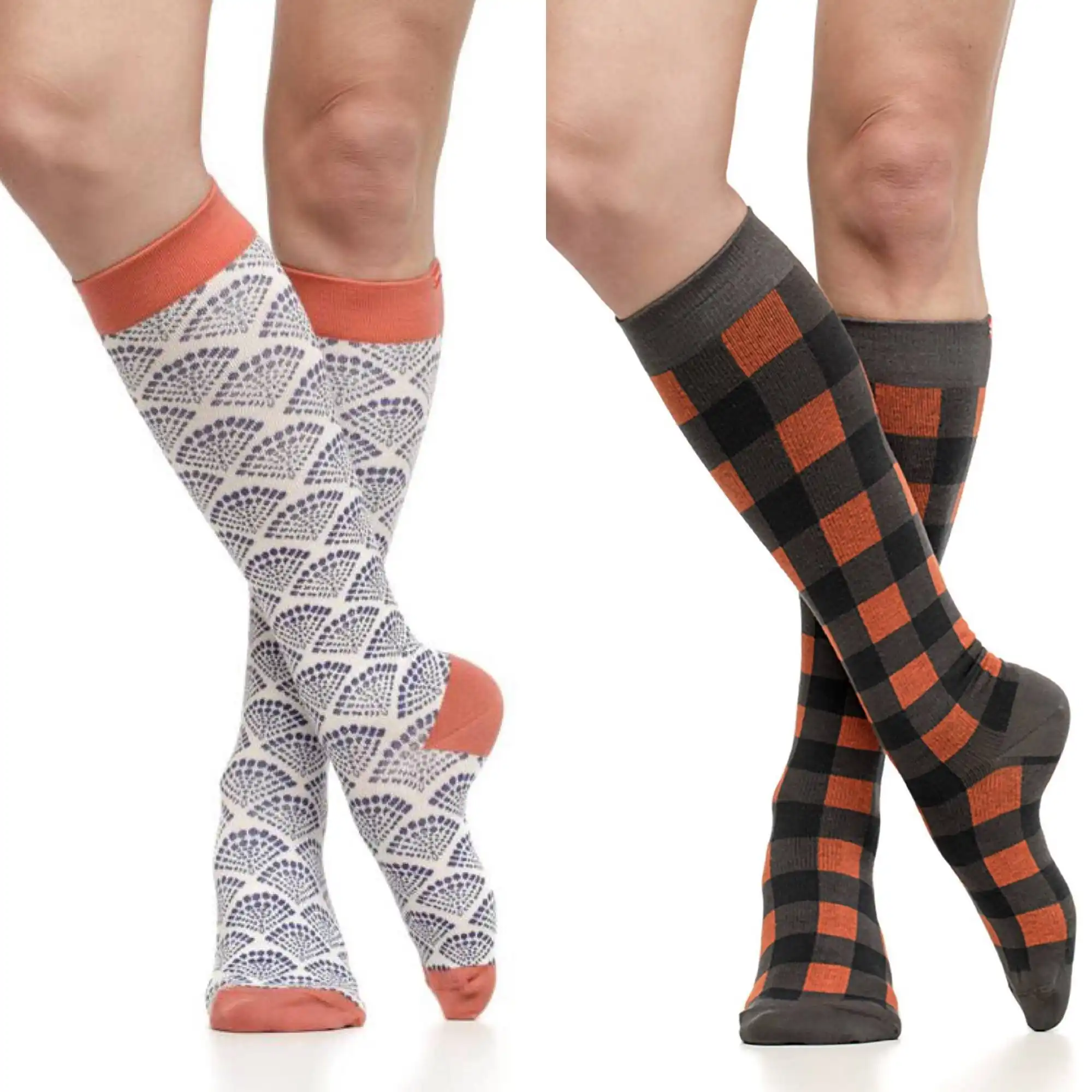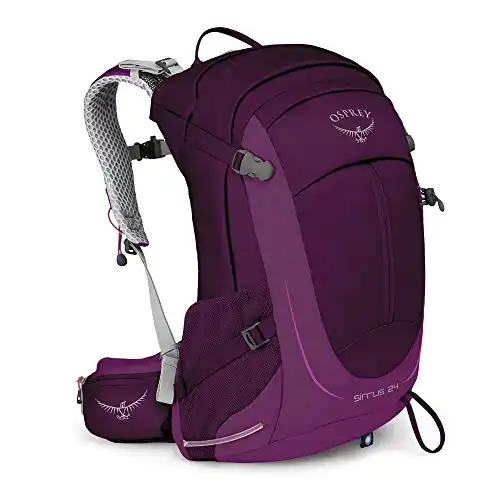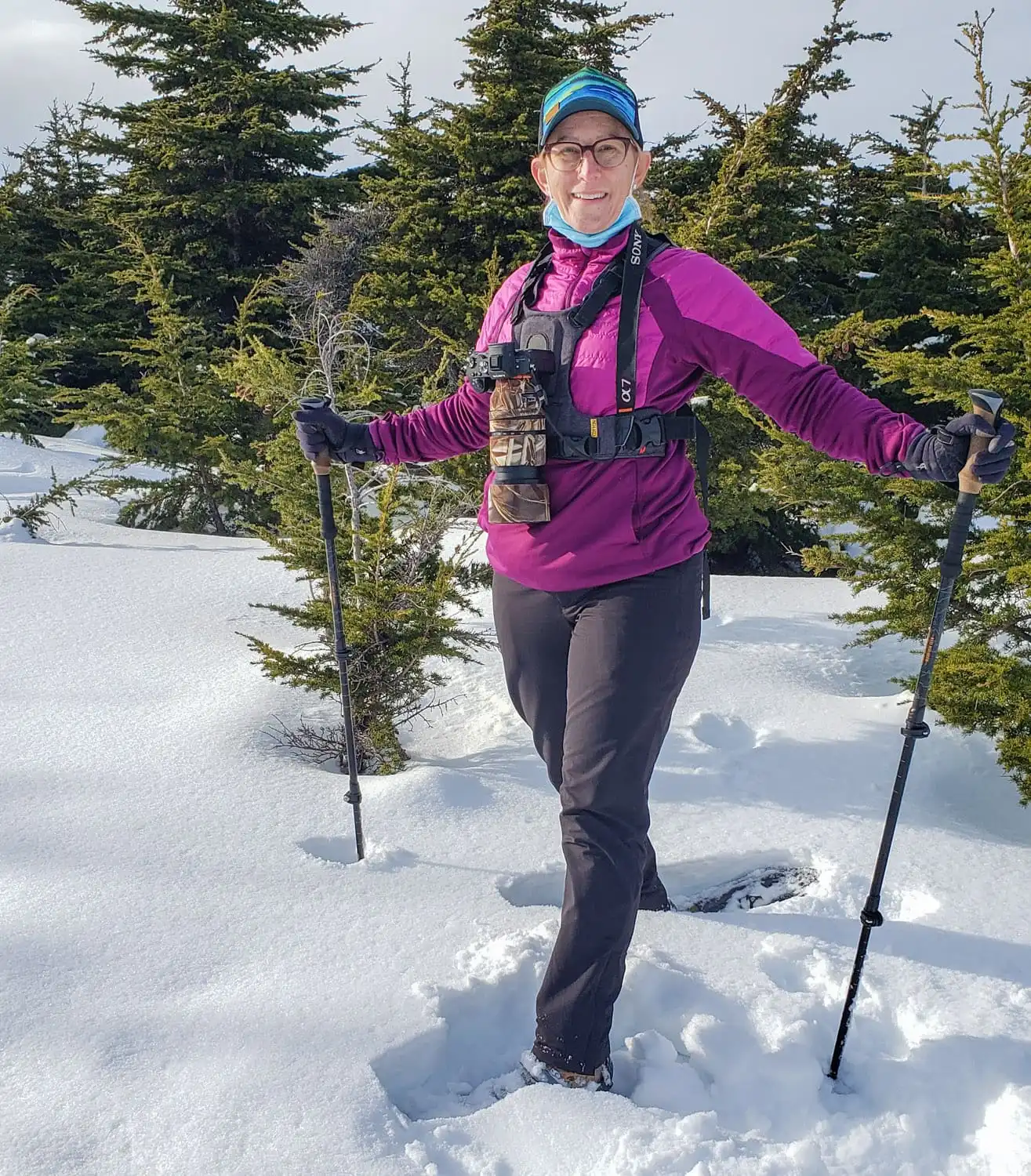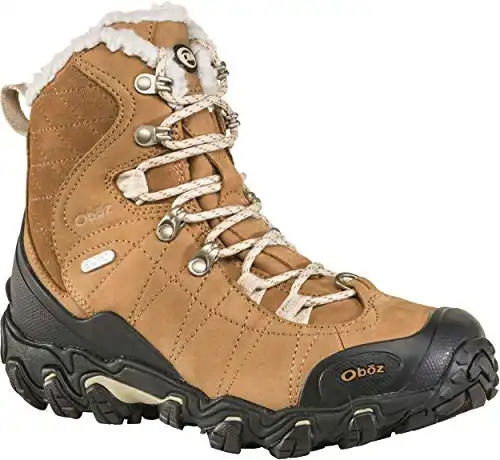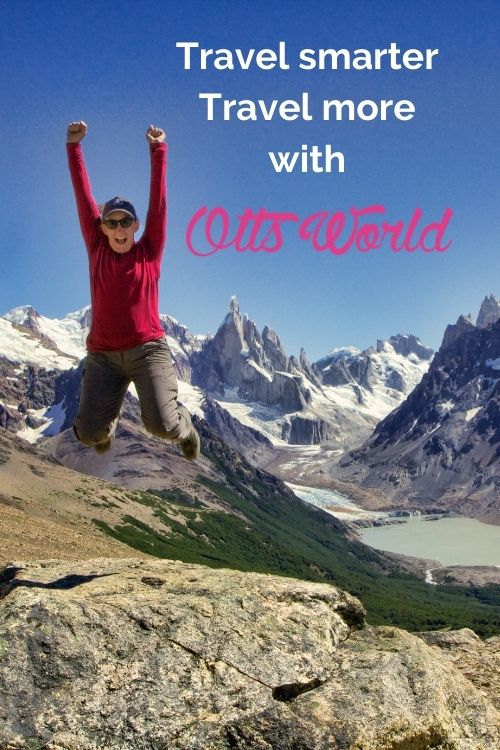I adore hiking; being outside, pushing myself, enjoying nature, and photographing beautiful views. However, when winter comes around, I’m always a little sad to hang up my hiking boots. Don’t despair fellow hiking lovers, you can still get out on the trails in the winter – all you need are snowshoes and to know what to wear snowshoeing!
I think most people are a bit freaked out about embracing the winter and getting outdoors. However, the pandemic has forced more people outside no matter what the weather. In fact – snowshoeing is seeing a big boom right now! I first figured this out when I went out to buy a pair of snowshoes and there were none to be found!
The snowshoe company, TSL, based in the French Alps, is producing it’s high-tech snowshoes at a record pace–and has a backlog of 40,000 pairs.
Hari Sreenivasan
But it’s possible to beat the fear of the cold by simply knowing what to wear snowshoeing, as well as see realizing just how easy it is to get out on a trail! Before you know it you’ll be working up a sweat and enjoying views and the outdoors, just like you do when hiking in the summer!
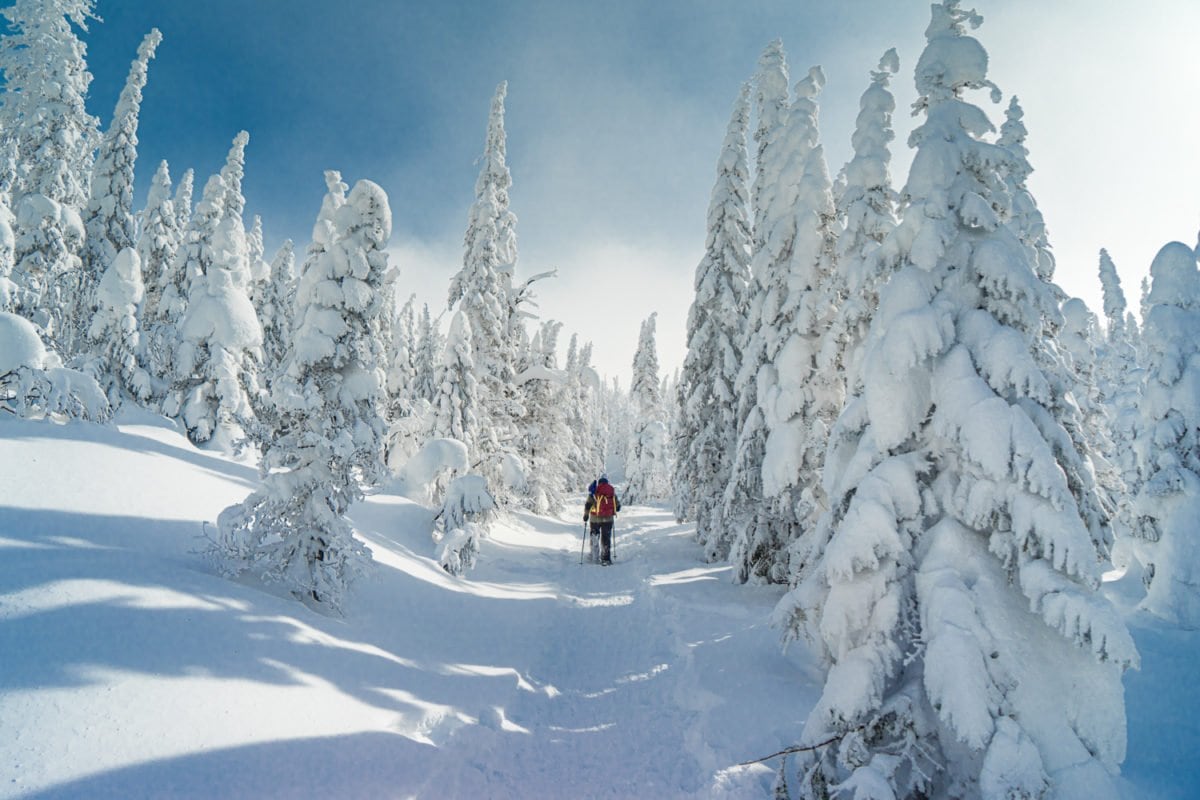
Table of Contents
How to Snowshoe – Beginner Snowshoeing is Similar to Hiking
If you know how to hike, then you know how to snowshoe. You are still following a trail, all of the regular hiking safety and essentials apply, and it is a great form of exercise.
However, there are a few things that make snowshoeing different than hiking.
It takes more effort
I find that I’m not normally aren’t able to snowshoe as fast as I can hike, so that means you may want to find shorter trails, to begin with. Snowshoeing requires more effort because you are picking up your knees higher to get in and out of the snow normally.
Plus – here’s the best news…it burns more calories than hiking! Your body must work hard to maintain and keep you warm therefore burning calories.
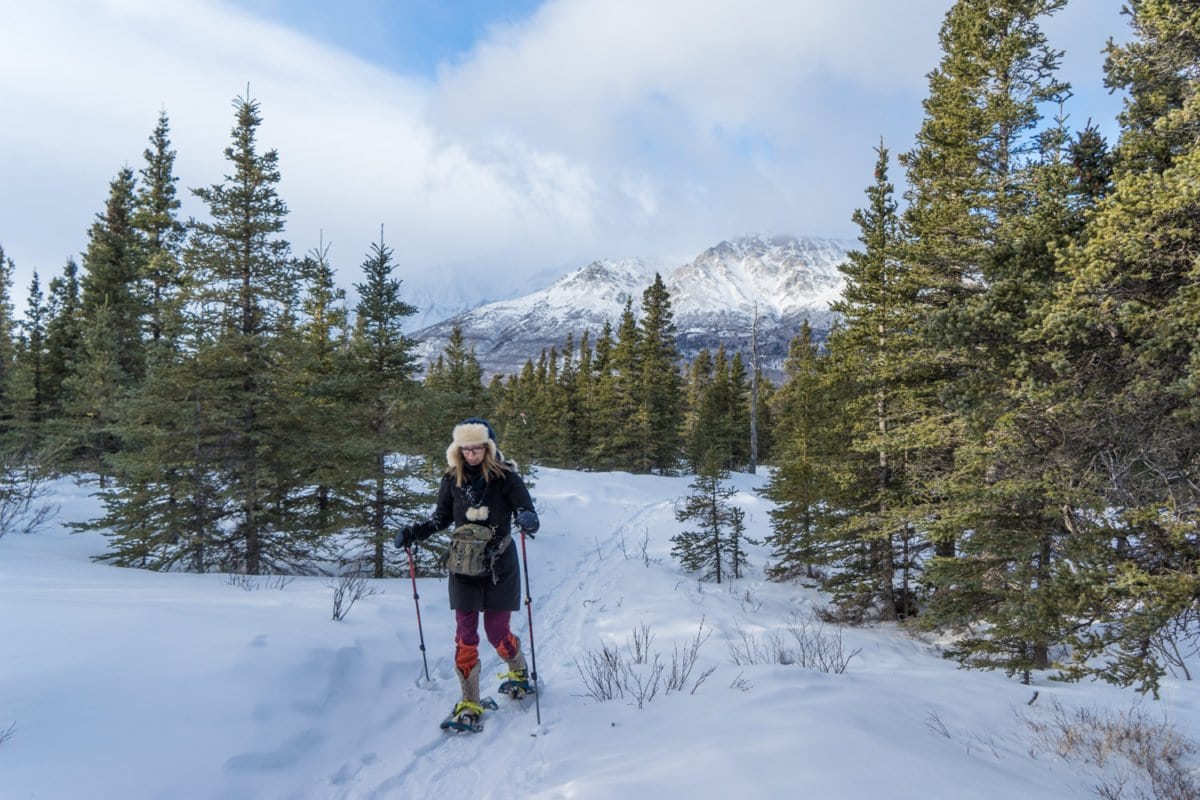
It engages your core muscles more
Snow is a bit like walking in sand, it’s not as stable and as easy as walking on a dirt trail. Therefore, your body and core muscles especially are always working at trying to steady you, and therefore those core muscles work harder. And an added benefit of this is that snowshoeing improves your body balance overall!
It requires more gear
I’ll be talking a lot about what to wear for snowshoeing below, however, suffice it to say snowshoeing requires more gear than hiking. Unless of course, you want to freeze to death…and that doesn’t sound very fun.
It’s easier to not get lost
This is some good news on the beginning snowshoeing front (finally!) – it’s much harder to get lost when you are snowshoeing because you have an immediate breadcrumb trail left for you in your snowshoe tracks! That also means it’s a bit easier to navigate off the trail and blaze your own trail. Note – remember, try to stay on the trails when you can, it’s always better for the environment and landscape that way.
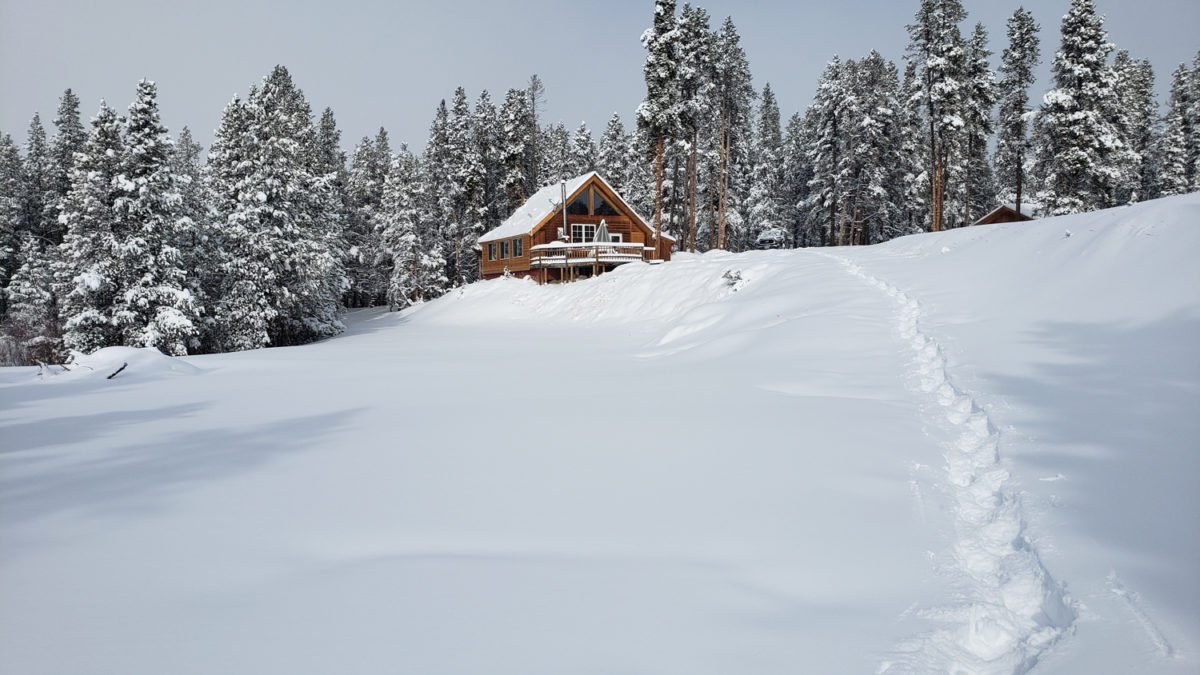
Wider foot placement is necessary
Have you ever ridden a horse for a while and got off and walked funny with a wider foot strike? Well – snowshoeing requires a wider foot strike than hiking due to the width of the snowshoes. Granted most snowshoes are designed to minimize that, but the fact is that your snowshoes are wider than your hiking boots and you will likely get tripped up, in the beginning, a little. I normally always step on the inside of the frames at first. The good news is that your brain is a power machine (even in the cold!) and it sends signals to your legs to adjust your stride pretty quickly.
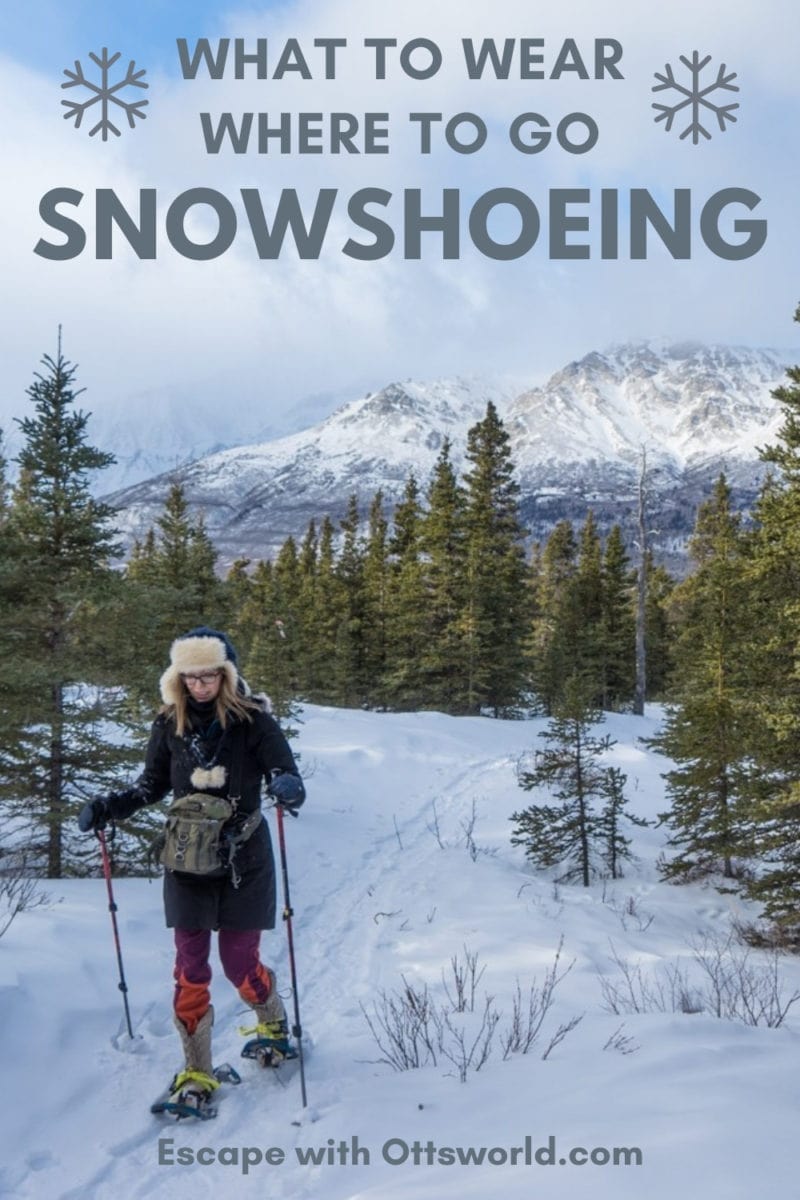
It takes longer to put on Snowshoes than Hiking Boots
This is one of the little things that annoy me about snowshoeing (more on this annoyance below), it’s not as easy as you getting out of your car and heading right onto the trail.
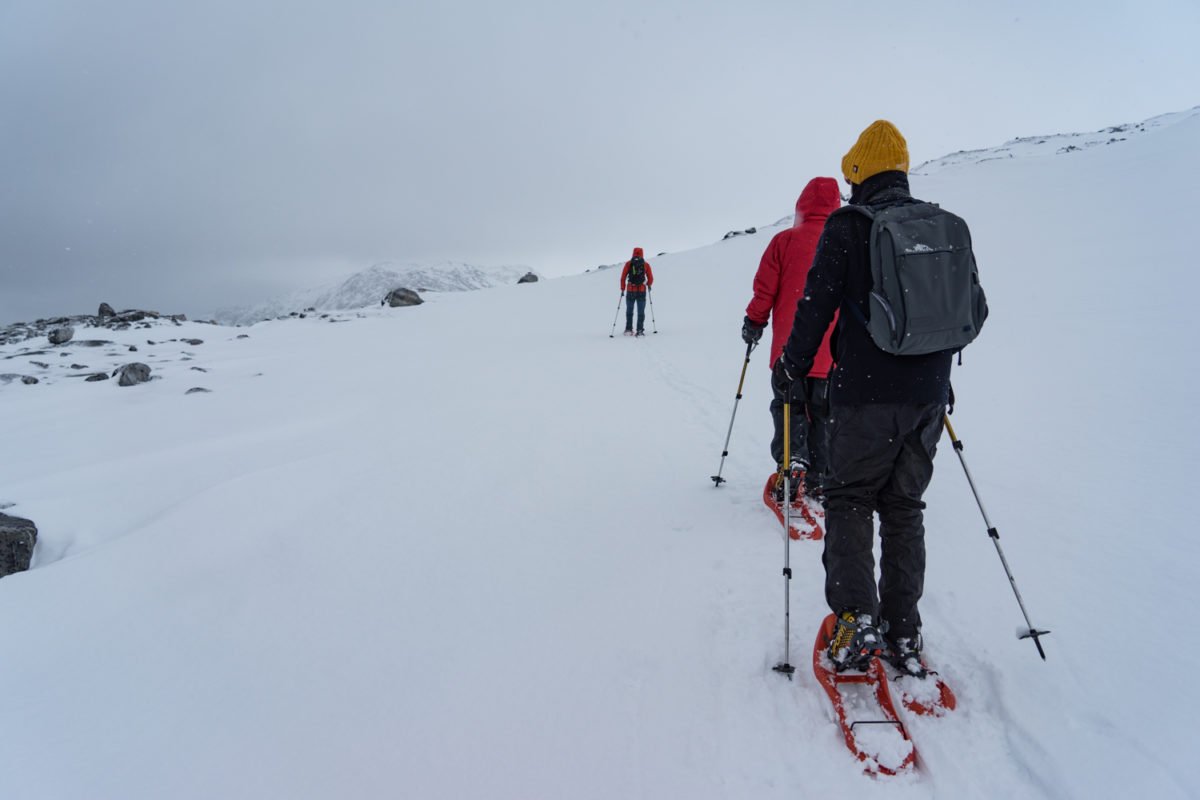
Specifically, you wear hiking boots AND then have to put on snowshoes. Snowshoes have to fit various types of boots which means you have to strap them on your boots and get them all tightened up just right. This isn’t necessarily hard – but the strapping and unstrapping are sort of annoying – especially when it’s cold out and you have to take off your mittens to get them all tightened up. Yes, I know I know…this is minor…but apparently, I’m a princess, and I hate to start with cold hands!
Where to go for fall colors in Alaska
How to find Good Snowshoes for beginners
As I said above, snowshoes are actually pretty hard to find these days. So you might not be able to find anything to buy this year.
But don’t despair because honestly, my best advice is to try a few before you buy. I had gone snowshoeing for years by renting them on short tours before I finally bought my own pair this year. By renting them, you get to see what you like and what you don’t.
In most places where there are snowshoe trails, there are places to rent snowshoes – especially in the Colorado mountains where I live. However, another place to try to rent them or at least research them is sports gear stores. My favorite is REI as they sometimes have in-store clinics on snowshoeing too that will walk you through snowshoe basics, and show you the different types. But at the very least – go to a store and talk to someone there about the different features.
Another potential place to look for snowshoes where you don’t have to invest much to try them is on Facebook’s marketplace.
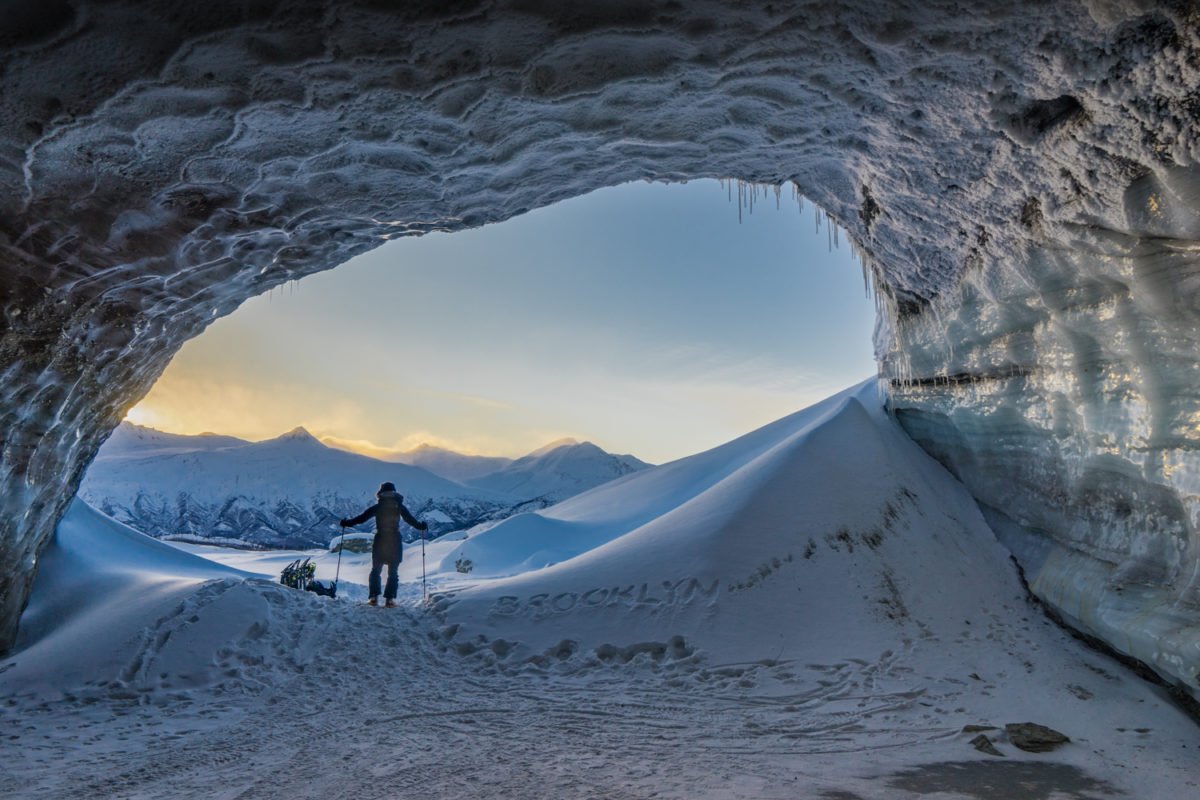
Snowshoe Sizing
Even though it has the name ‘shoe’ in the name, snowshoes have nothing to do with shoe sizing, it has to do with your weight. Snowshoes allow you to ‘float’ on top of the snow, and in order to do that, they have to ‘float’ your weight. The bigger the surface area of the shoe is the more weight it can support to make sure you ‘float’.
You’ll find them sized by weight and sometimes by male and female. Generally, men’s snowshoes accommodate bigger boots and heavier weights. However, the main thing to be aware of is weight. And don’t forget to add on the fact that you may be carrying extra weight in a backpack too when you determine the sizing!
Different Types of Snowshoeing
There are also different types of snowshoes for different types of terrain ad activities; basic trails, powder, mountain climbing, running, and racing are some that come to mind. Each of these specialized areas can have specialized designs. They can vary in material, size, traction, and more.
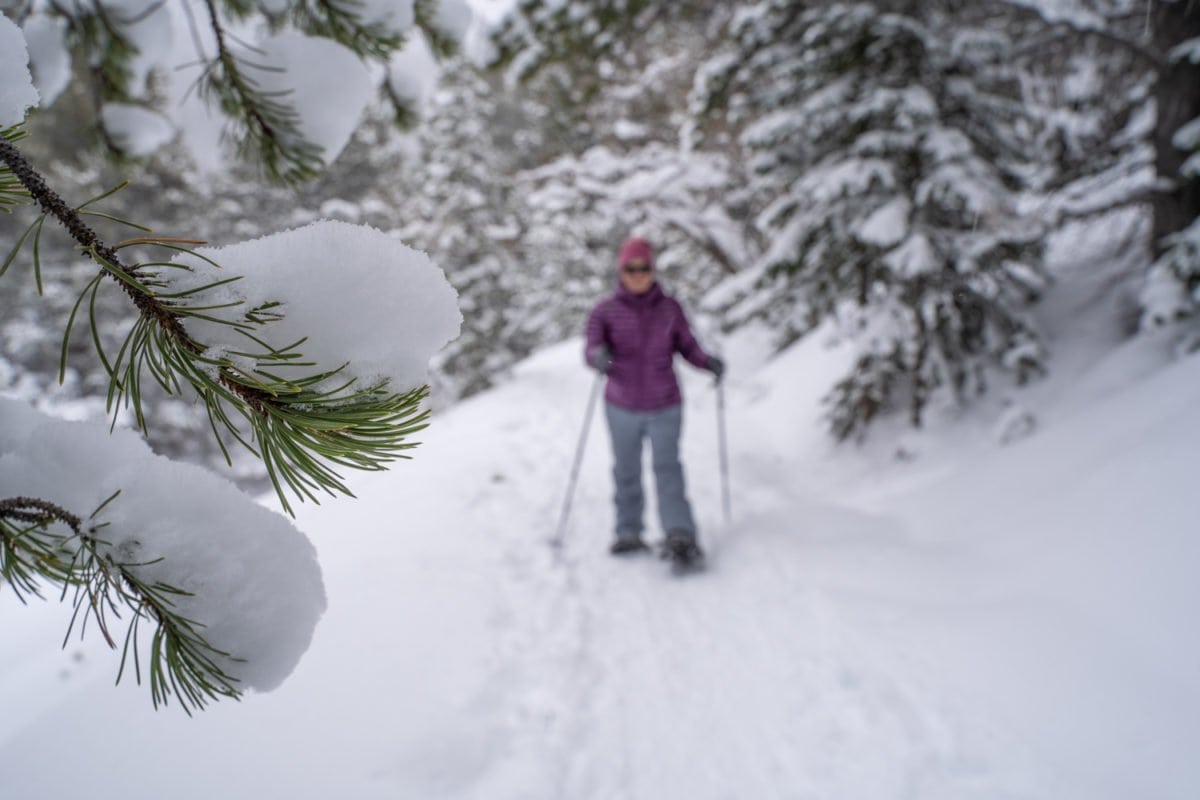
As a beginner, I suggest you get something that can be a bit of all of these things instead of specializing in a very specific type of activity. This is also why it’s great to rent snowshoes at first so you can try out some of the different varieties and see what you like best.
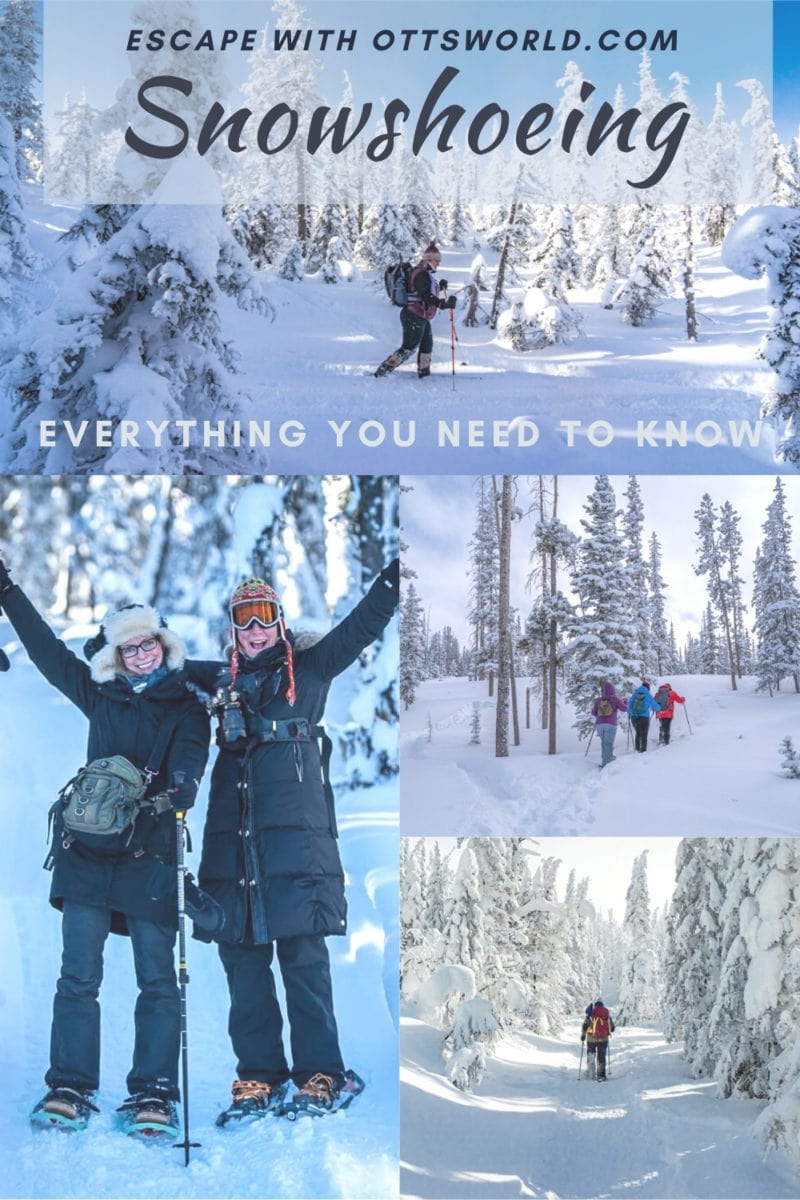
My Snowshoes – I LOVE Them
Ok, let me tell you about my snowshoes – they were a big purchase for me this year and I love them! After years of renting snowshoes, I decided to finally buy some.

I bought the TSL 325 Adjust Snowshoes from REI (sadly no longer available). They are made of a composite which makes them really light. They are made for rolling terrain, but will crossover into different types if necessary. However, the main reason I got these is due to their ease in putting them on and strapping them onto your boot. As you may remember above, that was one of my most hated things about snowshoeing, so I made sure that the pair I bought solved that problem.
They have easy-to-use lock adjustments that memorize your shoe size for all your snowshoeing outings. And there are only two easy ‘straps’ you have to deal with to secure them. One is an ankle strap that tightens through an easy ratchet system for a secure and fast fit, and the other is the front toe box ‘strap’ that is a super simple Boa® Fit System where you simply have to turn a dial. I can get in and out of these snowshoes in record time with no cold fingers fumbling around trying to tighten things!
They have an hourglass shape to them which means you are much less likely to step on a side rail. In fact, it’s the most comfortable stride I’ve had with snowshoes as I didn’t have to walk as wide.
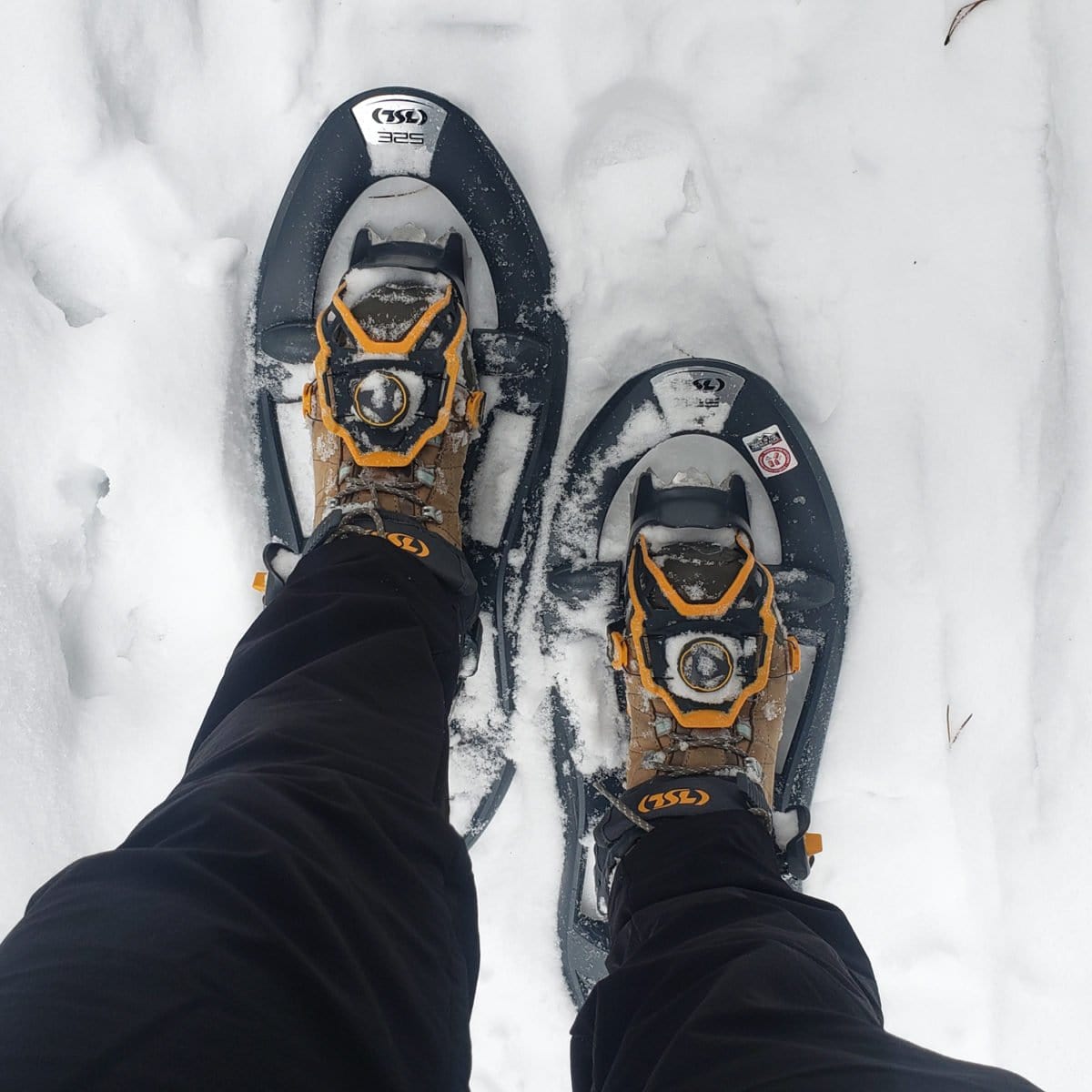
One of the coolest features snowshoes offer is heel lifts. When climbing steep terrain or mountains, you can flip up wire bars under your heels to help reduce calf strain. And yes, mine have heel lifts. The first time I ever rented shoes with lifts was in Greenland, and it was a game changer. Ever since then, I knew I wanted snowshoes with heel lifts!
What to Wear Snowshoeing
Okay – you’ve finally made it to the snowshoeing gear section that is the most important thing when snowshoeing because more than anything you want to stay warm and be comfortable.
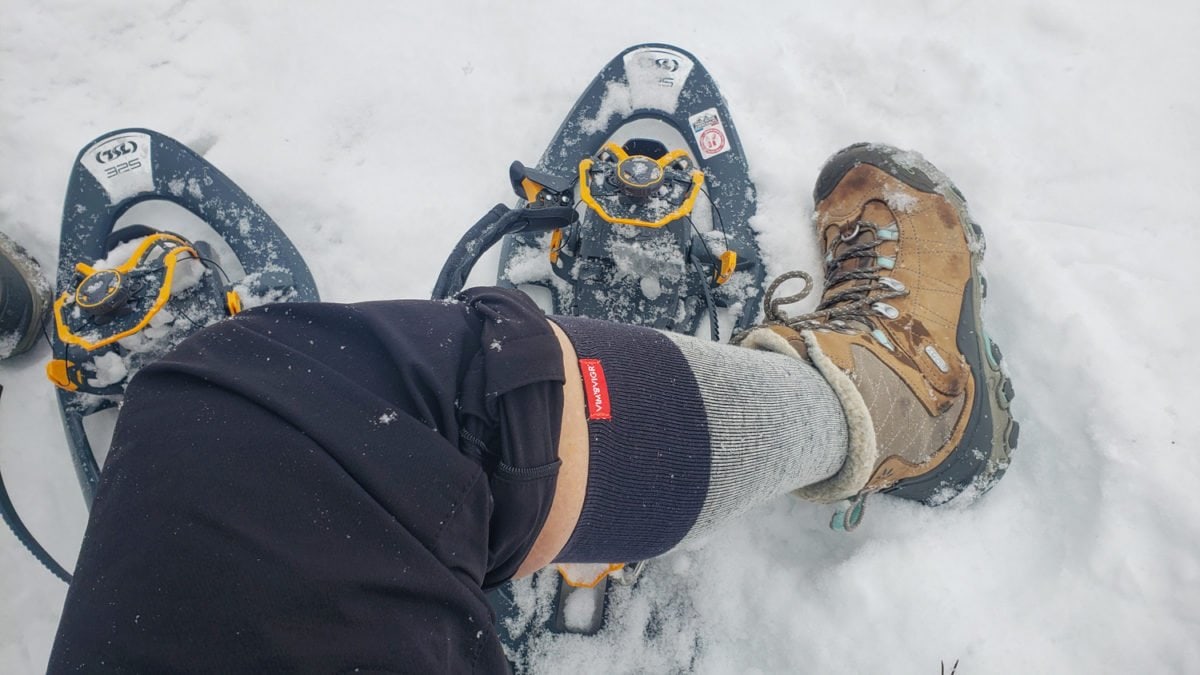
Staying warm is easier than you think when snowshoeing. This is because you burn so much more energy snowshoeing than practically any other winter sport. Quite frankly, I normally have more trouble with overheating than I do getting cold while snowshoeing!
Once I snowshoe for a bit, I start to really heat up, and it’s more important than ever to have wicking clothes so that you don’t overheat. It’s also important to have layers because it’s likely that you may start shedding layers on a sunny day once your body has warmed up! That’s why I tend to dress lighter than I think I initially need because I know I will warm up. But it’s always good to have warmer gear in your backpack just in case.
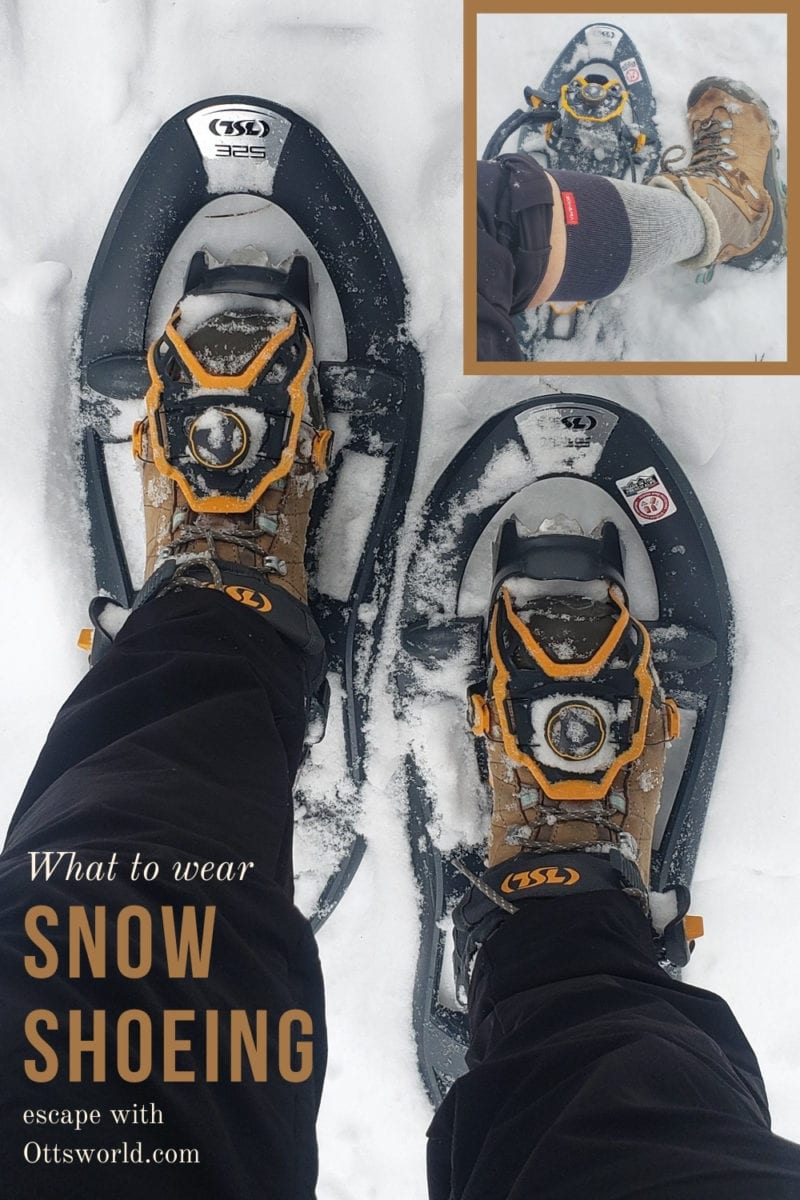
Here’s all of the snowshoeing gear I use and love
Reviewing a piece of gear implies actually using that piece of gear for an extended amount of time. I use the gear I’m writing about, not just once, but many times.
Turtle Fur Hat and Neck Gaitor/Warmer
You always need a hat in the winter, if you get too hot it’s one of the easiest things to take off and immediately cool down since heat escapes from your head mainly. I love the variety of hats Turtlefur offers – check out their complete offering!
Beanies that pack a punch! Merino wool manages moisture, retains heat, and is fully-lined with fleece, meaning it feels soft against your skin - no itch!
Their neck gaiters and tubes are the best. I say that because they are so soft! I love the soft fleece against my neck and face. These are also a great piece of snowshoeing because they aren’t as bulky as a scarf swinging around, yet they keep you just as warm as a scarf.
The Pipe Dream™ is a heavyweight neck warmer fully lined with super soft micro fleece to trap heat and stay put, all while keeping you cozy and comfortable
Heat Company Gloves
These are my favorite cold weather gloves because they come as a layering system; liner, shell (arctic mitten), and a polar hood (wind mitten). You can decide what layers you need to wear based on the temps. Plus – when you have the super warm mittens on over the base layer, you can easily unzip the tops, fold back, and have your fingers free quickly without having to take off your entire glove! The fold-back mitten has a magnet that holds the flap – ingenious! And finally – there is a little pocket in the liner glove to put in a ‘Hot Hands’ pack to stay nice and warm!
The warmest glove system: No more freezing or sweating! Depending on the situation, you can flexibly choose the right LINER inner glove and combine it with the SHELL mitten and the HOOD pullover mittens.
Soft Merino Wool Gloves – Premium Quality – Touch Screen Gloves For Women & Men. Pocket to hold hand warmers in place.
Heated Gloves
However, if you are the type that always has cold fingers then you might want to consider battery-heated glove liners from Gobi Heat. This battery technology is constantly improving and providing longer life!
6 hours of Heat | Battery and Charger Included | Heat Up and Around Each Finger | Heated Gloves
Marmot Scree Pants or Ski Pants
For the really cold weather – I wear some Marmot ski pants as my top layer. However, my favorite snowshoe pants are my Marmot Scree pants. They are made of a heavier fabric but aren’t nearly as insulated as ski pants. I like these because they are stretchy, water repellent, and best of all they aren’t too heavy so I don’t overheat. I wear a layer of long underwear under them and that’s normally all I need unless I’m in temps below 15 F.
Remember – you heat up quite a bit when you snowshoe!
These make great winter hiking pants. They're heavier, with fleece pockets, stretchy, and great for snowshoeing. I consider them midlayer pants offering extreme water repellent, stretchiness, softness, and packability - Yay! I have multiple pairs!
Krimson Klover Base Layer
I love this ultra-soft base layer (tops and bottoms) for winter layering. Another option of course is Smartwool base layers which are also awesome. I wear my Krimson Klover layer closest to my skin. It’s tight and wicks away the sweat.
This seamless top is a perfect high-performance base layer for your winter adventures from sunrise to sunset!
Krimson Klover has my favorite base layers! Not only are they warm and comfortable, but they have cute designs. Designed in Boulder, CO. For women, by women.
Lip Balm and Sunscreen
Remember any time you are out in the snow, the glare of the sun can fry you! Don’t forget the sunscreen for your face and lip balm! I often just use a zinc face screen and that takes care of everything when snowshoeing since every other part of your skin is covered up! Here are the favorites I frequently use.
-
$19.99 ($6.66 / Fl Oz)Buy Now
Golden amber tint ensures you don't have a white pasty look of mineral sunscreen!
Reef safe, fragrance free, With all-natural, ingredients, and zinc oxide as the active ingredient, you can feel confident in your daily skin protection. Women owned.
I earn a commission if you click this link and make a purchase, at no additional cost to you.
03/08/2024 04:02 am GMT -
$12.84 ($24.23 / Ounce)Buy Now
Vegan and Reef Friendly (Octinoxate & Oxybenzone Free) Broad Spectrum Natural Sunscreen with UVA/UVB Protection | .45 oz
I earn a commission if you click this link and make a purchase, at no additional cost to you.
03/07/2024 08:32 am GMT
Balaclava for Real Cold Weather
If it’s really cold (like in Fairbanks Alaska), I wear my Magneamask balaclava. It has a full face mask that is breathable. But the best part is that the face mask is held in place by magnets. That means it’s easy to just pull it down if you need to drink or just want some fresh air!
OMG - I love this for really cold weather! The mask is secured by a magnet and it's easy to pull down and flip back up. Breathable and warm!
Hand and Feet Warmers
Also for really cold temps – it’s always good to have a few hand warmers with you. Not only can they help in an emergency, but they are also great for keeping camera batteries from draining!
Or skip the packets and get some Gobi Heat heated socks if you are looking for a permanent solution! The batteries will last up to 12 hours and can quickly be recharged.
Out of all of the heated products out there - I find the socks work the best.
They use a steel fiber heating technology and dual slim 2,400 mAh Lithium Polymer batteries allow for extended heat during longer day trips. They warm up within 30 seconds so feel more comfortable immediately!
12 hours of Heat | Battery and Charger Included
Winter Jackets
I have a couple of different puffy coats I wear. A lighter one from Big Agnes is my favorite because it doesn’t take me long to get hot snowshoeing and this one is just the right weight.
A great lightweight, breathable winter jacket super for active winter adventures like snowshoeing.
I also have a heavier Marmot puffy jacket that I use when it’s a bit colder.
A great warm puffy jacket perfect for winter adventures like snowshoeing! It's lightweight and fits in your pack easily.
Finally – I suggest bringing a raincoat too in your backpack as they are great for windy days to put over your puffy coat.
Sunglasses/Goggles
In the extreme cold temps, I also like to wear ski goggles for snowshoeing. They are also great if it’s windy. In the less extreme temps, I just make sure I have sunglasses. The snow glare is real, and you want to keep those eyeballs healthy! Make sure that your sunglasses or your goggles are polarized.
Gaiters
If the snow is really deep I’ll bring my hiking gaiters – it’s just another level to ensure that snow doesn’t get in your boots. Honestly, I don’t use them that often – but gaiters are nice to have with you just in case.
Good for muddy hikes, buschwacking, or chilly mornings.
Poles are Essential for Snowshoeing
Even if you are a person who doesn’t use hiking poles, you’ll want to bring poles with you snowshoeing. Mainly because they can help you get up if you fall through deep snow (this is harder than you can ever imagine…the struggle is real!) or go off trail. If the snow’s too deep for you to poke a pole down against the ground and push yourself back up, then you’ll need to get inventive. I’ve been taught to place both poles flat on the snow, upslope from you, and crossed in the middle so they make a big “X.” Place one hand where the poles cross and use that support to get your feet back underneath you.
In addition, poles are necessary for understanding how deep the snow is at times. And finally – they help with balance – which you tend to need more help with balance while snowshoeing!
Just make sure that your poles have snow baskets on them – a big disc that sits just above the tip of each pole, keeping it from sinking too far into the snow. If they don’t – the poles are sort of rendered useless since they will sink all the way down to the ground…which can be 5 to 10 feet deep at times!
One Pair (2 Poles) - Ultra Light, Quick Locking, and Ultra Durable
Compression Socks
I wear
Compression socks are great for faster muscle recovery and to fight blood clots on long flights or long road trips.
PLUS - use discount code OTT15 for 15% off orders!
Daypack Backpack
You will absolutely want to take a backpack with you. My favorite daypack is the Osprey Sirrus. It has a great water bladder (load up on water while snowshoeing!), plenty of room for a first aid kit, plus storage for layers when you get too hot! But the best thing about this pack is how easy it is to store poles; they call it the stow-and-go. In fact, you don’t have to take off the pack to store or get your poles – that’s ingenious – and that’s why I love this backpack!
This is my 'go-to' day pack for hiking. It's got a great hip belt and support. It comes with a rain cover - no need to buy it separately! My favorite feature is the Stow and Go Trekking Pole functionality - you can store and easily get out your hiking poles without taking off your pack! Big water bottle holders and space for a water bladder! The perfect pack!
Cotton Carrier Harness
I don’t go on a hike without this piece of equipment and I won’t go snowshoeing without it either! It’s the perfect hands-free way to carry a camera so that it is secure and not bouncing around. In addition, it takes the strain off of your neck! It’s a favorite all-around piece of travel gear.
I don't go on a trip without this harness! It allows me to be hands free when hiking and snowshoeing. I've also used it while horseback riding. It has saved my neck and back and it a secure, healthy way to carry my camera!
10% off coupon code for readers - OTTSWORLD
Best Boots for Snowshoeing
Yes – you can wear any kind of boots for snowshoeing, however, I think boots are pretty important when it comes to what gear to use for snowshoeing. The three most important things when it comes to boots for snowshoeing are their warmth/insulation, resistance to water, and their support.
I use the Oboz insulated tall Bridger boot. They are waterproof and have breathable membranes to keep feet dry. Their insulation is top-notch Thinsulate™, with thermal insoles, and faux-fur trim. Your feet will stay warm!
And my favorite thing about using the insulated Bridger for snowshoeing is its foot support. When I do any kind of walking, hiking, or snowshoeing midsole support is really important to me; it protects you from injuries and allows you to go further. After all, you wouldn’t hike 5 miles in flip-flops with no support, would you? So you want good boots and arch support for a 5-mile snowshoe outing too!
Sooo - comfortable and warm! These are my go-to winter insultated boot. I use them for snowshoeing and everyday around town stuff when it's really cold. O Fit Thermal insoles provide stability and support while reducing heat loss to keep your feet happy!
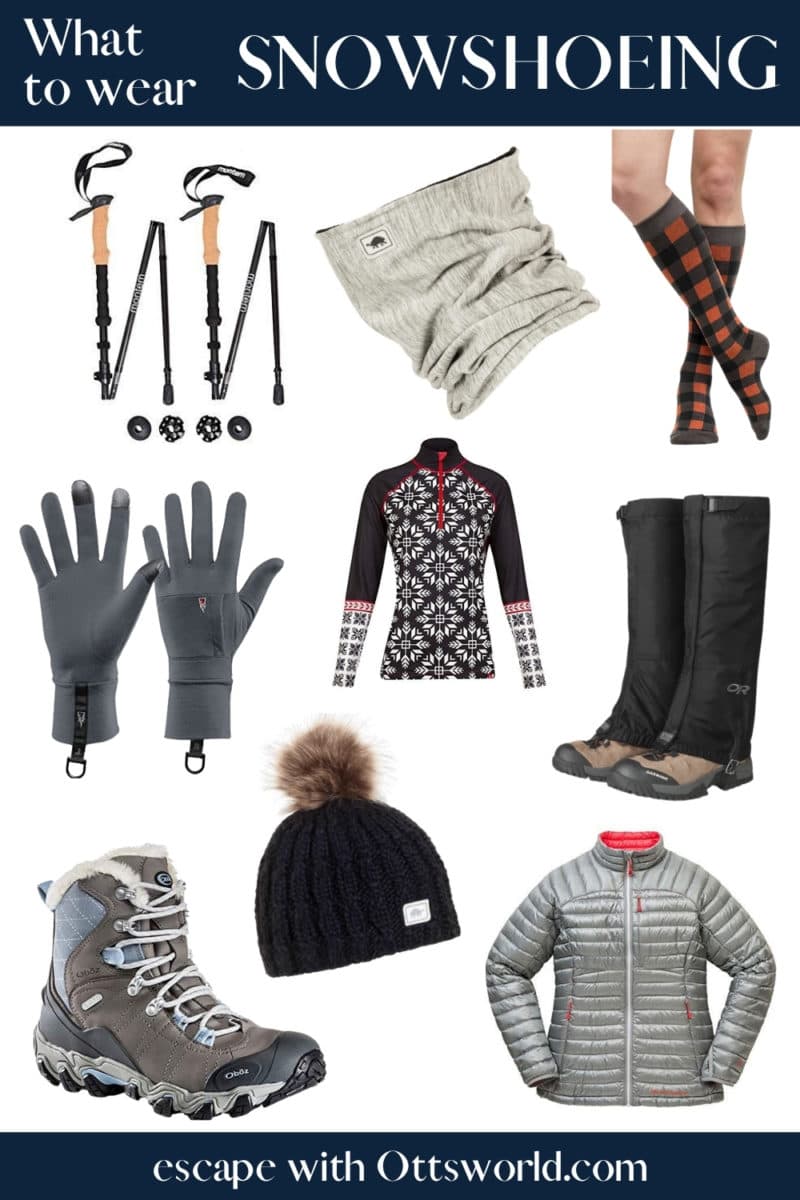
Where to Go Snowshoeing
I’m lucky enough to have snowshoes all over the world during my travels. But since I live in Colorado, I’ll cover that first.
Colorado Snowshoeing
Winter Park Ski (and Snowshoe) Train
Basically, every Colorado ski town has a snowshoe rental and tours (https://theknow.denverpost.com/2019/01/23/snowshoe-hikes-colorado-ski-resorts/206698/). One of my favorite ways to snowshoe is to take the Ski Train to Winter Park. This unique Amtrak winter train starts at Denver’s Union Station and winds through the mountains for 2 hours as the sun comes up. The train stops within a few hundred feet of the ski lift, right in the middle of the village!
I took it last year and it was an incredible trip through the mountains. I went snowshoeing for 2 days in Winter Park and simply rented shoes from the base of the mountain. Winter Park, much like most ski towns, has trails at the top of the mountains where you were able to ride a gondola to the top. They also had trails along the river at the base of the mountain.
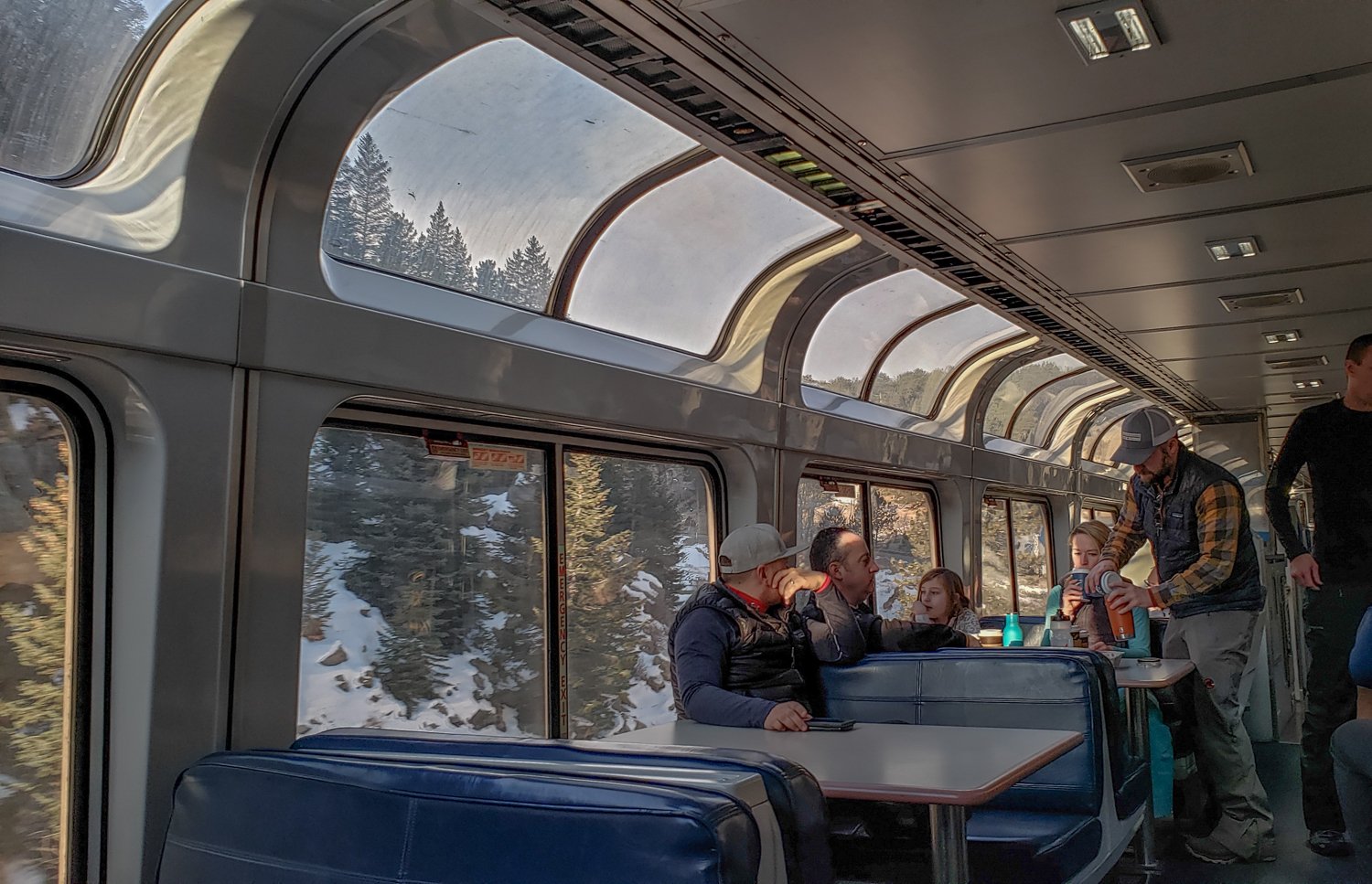
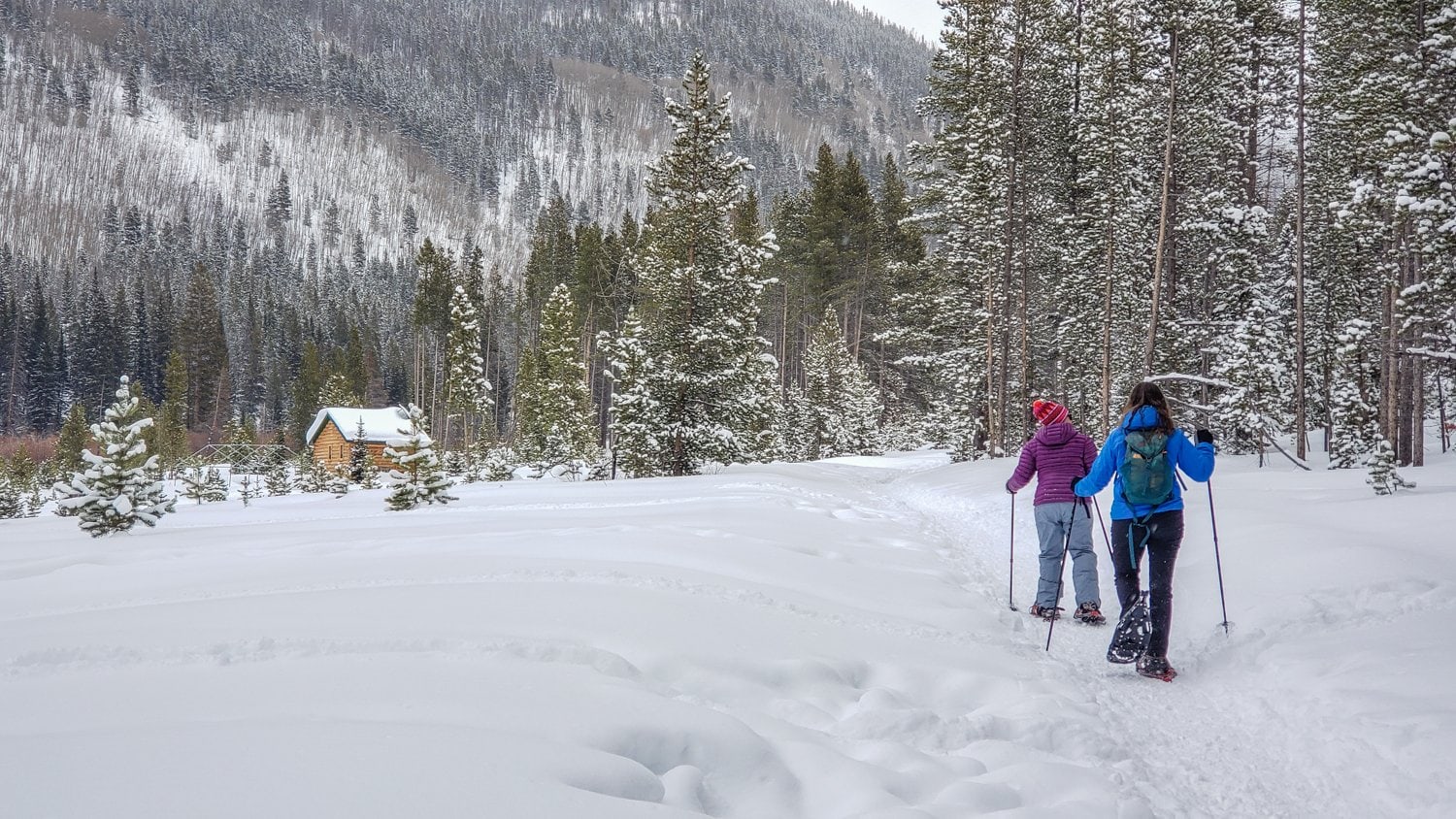
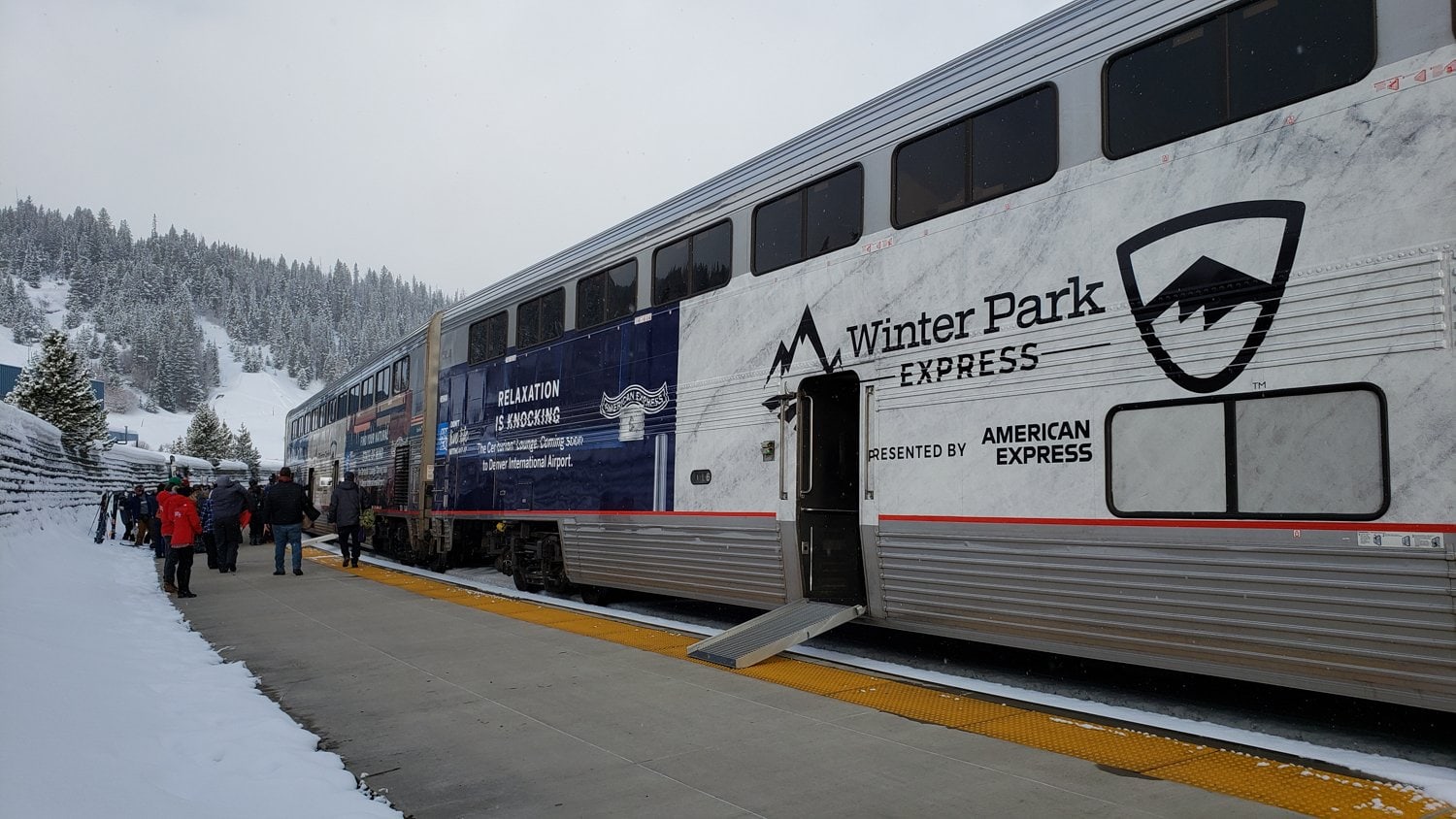
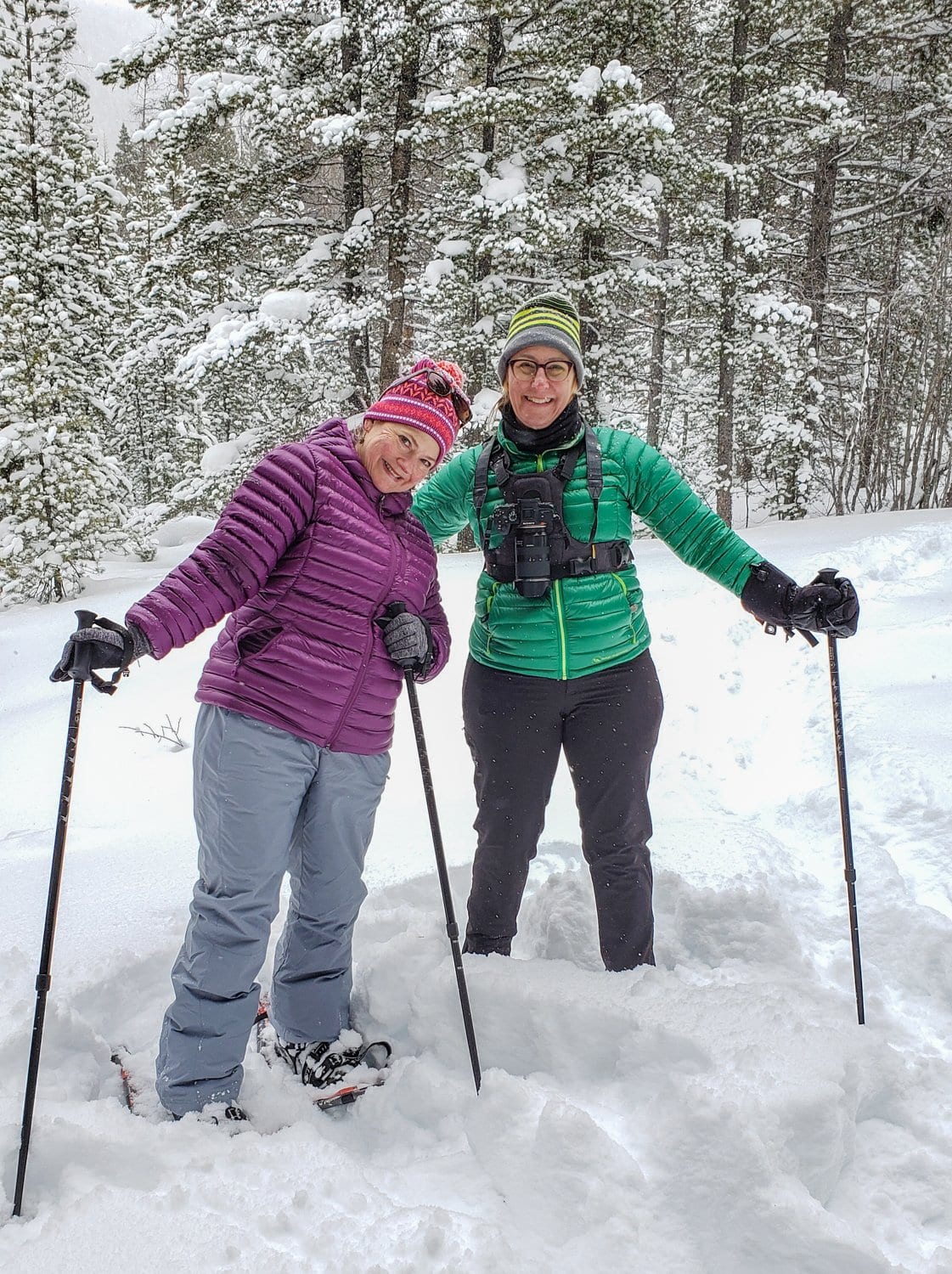
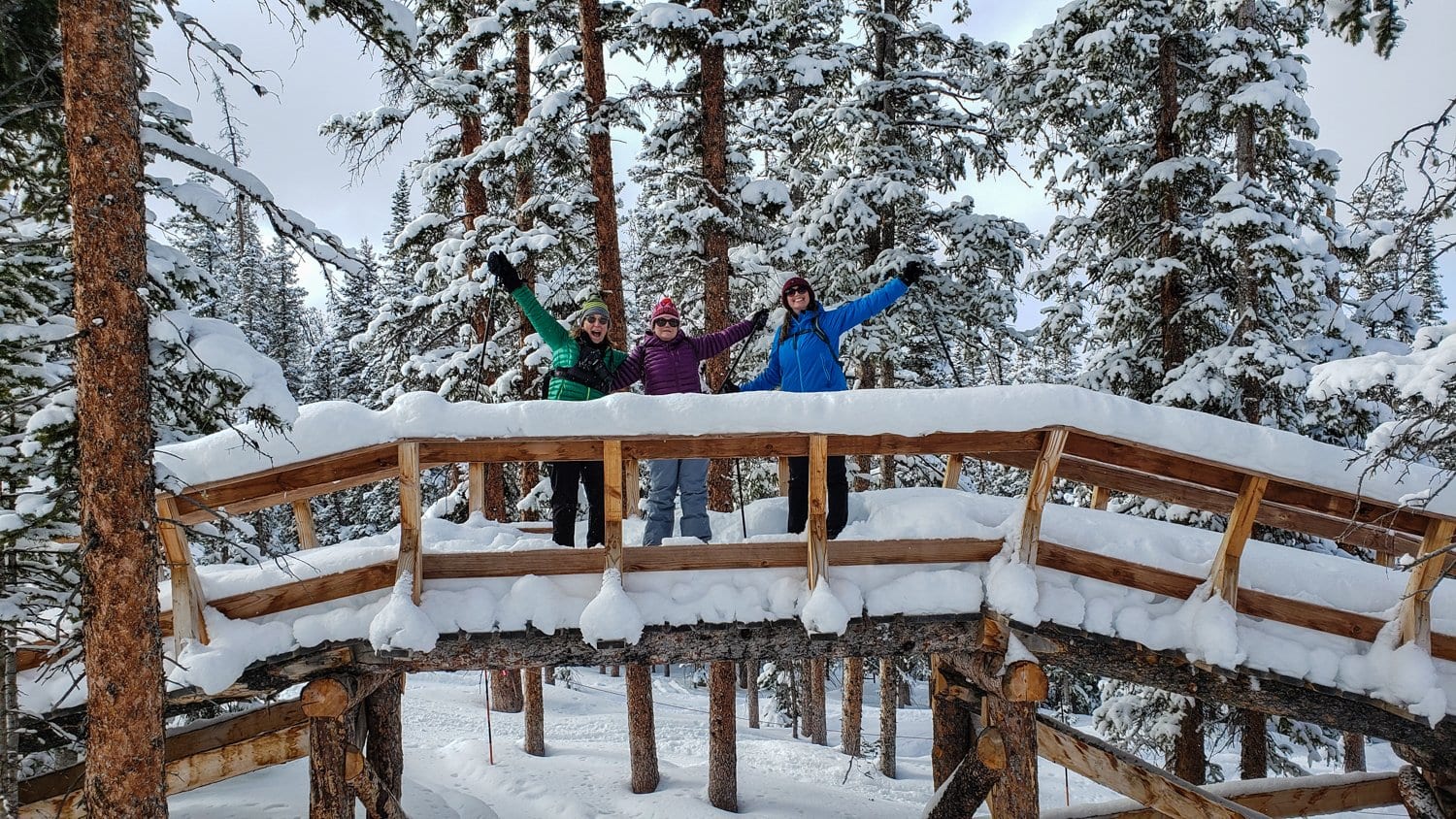
Rocky Mountain National Park
Snowshoe in Rocky Mountain National Park: Rocky Mountain National Park offers some of the best ranger-led snowshoe programs in the state. Two-hour excursions begin at both the west (Grand Lake) and east (Estes Park) entrances from January through March.
Find out why an Alaska train trip should be on your winter itinerary
Colorado Ranches Offer Snowshoeing
In addition to ski towns, many ranches offer snowshoeing in Colorado. I know that Vista Verde Ranch near Steamboat Springs offers snowshoeing as part of its activities.
And even though it’s not an actual dude ranch, the YMCA Snow Mountain Ranch outside of Winter Park is also a great place to go. There are miles and miles of trails there. I went a couple of years ago, stayed in a cabin with girlfriends, and snowshoed for a couple of days!
The best part about snowshoeing around Colorado – you can soak in hot springs after a great hike!
Snowshoeing Around the US
I think one of the best ways to find snowshoeing places and outings is to check out the REI day trip offerings! Just put in where you live and get an idea of the various snowshoe events REI has here. They supply the snowshoes too! I know they have beginner outings as well as moonlight snowshoeing around Denver!
Awesome Snowshoeing Trips I’ve Taken
As I mentioned earlier – I’ve been lucky enough to go snowshoeing all over the world. Here are a few of my favorite trips which may also give you some ideas!
Alaska Snowshoeing
Fairbanks Alaska in the winter is great for snow adventures because they get so much snow! This was a place though where I did have to wear some warmer gear (ski pants and a heavier puffy coat).



Quebec Snowshoeing
This was one of the most magical places I’ve ever snowshoed! The ghostly Vallée des fantômes, atop Parc national des Monts-Valin in the Saguenay region is one of the most unique winter landscapes I’ve ever seen. Trees are covered in snow so thick that they appear as ghost blobs in the landscape. The ghosts were incredible, but even more astonishing was looking at the snow-covered trees and knowing that they were buried in 8 feet of snow and we were just seeing the tops of the trees as we snowshoed through this incredible landscape!
Banff Alberta Snowshoeing
This is still one of my favorite tours I’ve ever taken. We snowshoed in fresh powder that day making it even more magical! But the best part about this snowshoeing tour was our guide, Nadine. Nadine’s enthusiasm was infectious, and I hung on her every word as she taught us how to see snow differently and understand the nature and winter wildlife in this winter wonderland!
Greenland Snowshoeing
While visiting Nuuk, Greenland’s capital city, I was able to get out with Marc the owner of Nuuk Adventure. He was a great guide leading us up 1000 feet of Lille Malene mountain for some lovely (yet snowy) views in April! Marc was such a great guide and taught me a bunch about snowshoeing from how to hold poles to posture.

Now you know how to snowshoe, what snowshoeing gear you need, and where you can go! You are ready to get out there and enjoy winter. Before you know it you’ll be heating up and ready to shed some layers!
